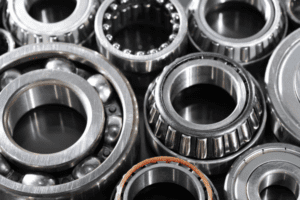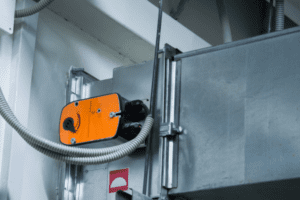In HVAC systems for your business, the commercial compressor plays a critical role in the cooling process. Without this component, your HVAC system won’t be able to extract heat from the indoor environment and transfer it outside in order to keep your commercial facility cooler in the intense summer heat.
Types of Compressors
Currently, HVAC commercial compressors are broadly classified as dynamic compressors and positive displacement compressors. In HVAC systems, dynamic compressors are mainly centrifugal compressors, also referred to as single-stage radial compressors. This category also includes axial compressors, which are used only in special applications. The positive displacement compressors are further divided into reciprocating, rotary, and scroll compressors.
Parts and Components
Depending on their type, function, and technologies included, commercial compressors use different prominent components, as described below.
The reciprocating compressors include:
-
Pistons and Cylinders
Reciprocating compressors use a piston to compress the air or gas. Because the piston moves from one end to the other end of a cylinder, these compressors generate a pulsating flow. Depending on the model and purpose of the commercial compressor, the piston may or may not have rings for sealing. Also, the cylinder is either directly bored into the compressor casting or made separately, and then fitted into the main body of the compressor. If the cylinder wall gets damaged or worn out, it can be repaired easily by adding a new liner during the compressor remanufacturing process.
-
Crankshaft
The crankshaft is the main shaft of the reciprocating compressor. One side of the crankshaft is connected to the electric motor, while the other side is attached to the connecting rod.
-
Connecting rods
The connecting rod connects the piston to the crankshaft, turning the rotary motion of the crankshaft into the reciprocating motion of the piston.
The rotary screw compressors comprise:
-
Rotors
Rotary screw compressors use two high-speed intermeshed helical rotors in place of pistons. The rotors have a special design that ensures a continuous, non-pulsating air flow for optimal performance. As a result, these compressors are more efficient than reciprocating models. Each rotor is connected to a shaft, which transmits the rotary movement of the electric motor to the compressor’s rotor.
-
Oil Filters
In oil-injected screw compressors, a filter removes the contaminants from the oil before it is sent back into the separator tank. Inside the separator tank, the oil is separated from the compressed air by centrifugal force. Depending on their models and the specifics of each application, oil-injected screw compressors may also include oil separation filters, oil pumps, and oil coolers.
The scroll compressors use:
-
Scrolls
A scroll compressor includes a fixed scroll and an orbiting spiral scroll, which are interleaved and in contact with one another in different places, so they form a number of crescent shaped pockets toward the center of the compressor. As the moving scroll orbits, the pockets move inward, toward the center, decreasing their volume and compressing the refrigerant gas progressively. Similar to the aforementioned compressors, a scroll compressor includes a shaft, which transmits the rotary motion from the electric motor to the orbital motion of the moving scroll.
-
Refrigerant chamber
The refrigerant chamber contains the refrigerant necessary for the cooling cycle to take place.
The centrifugal compressors include:
-
Impellers
In a centrifugal compressor, the impeller is installed on a steel shaft. When the impeller begins to rotate, the refrigerant is drawn inside and pushed toward its center. This movement creates kinetic energy. Depending on the pressure required, a series of impellers can be installed in a multi-stage arrangement. In this case, the compressor is referred to as multi-stage axial compressor.
-
Diffusers
As the refrigerant exits the impeller vans, it enters the diffuser, which converts the kinetic energy into pressure. The diffuser is connected to a volute casing, which collects the refrigerant and routes it to the discharge line.
Now, let’s review the other parts and assemblies commonly found in HVAC compressors.
-
Motor
Any compressor requires power to operate. The power is usually supplied by an electric motor.
-
Suction and discharge valves and pipelines
The refrigerant is sucked inside the compressor through the suction piping and valve. Then, the high-pressure refrigerant is discharged through the discharge valve to the discharge line, which takes it to the condenser. Another important component commonly found in compressors is the suction filter, which catches dust and debris as air enters the system.
-
Bearings
Depending on the type of HVAC compressor, bearings are used to support the shafts of pistons, rotors, scrolls, or impellers. These components are very important because they withstand the fluctuating loads during compressor operation and prevent metal-to-metal contact of the rolling elements to stationary castings, reducing friction-related wear.
-
Lubricators and oil pumps
While lubricators ensure adequate lubrication to the cylinder and other parts of the commercial compressor, oil pumps keep the running gear elements properly lubricated in order to avoid premature damage.
-
Gaskets, piston rings, shaft seals
These components ensure there are no refrigerant/oil and air leaks from the compressor.
Other elements, such as intercoolers, after coolers, and relief valves, can also be incorporated, depending on the compressor type and application requirements.
Whether you’re looking for a new or remanufactured commercial compressor, aftermarket parts, or accessories, Compressors Unlimited offers a wide range of products that can fit many different commercial and industrial applications.











